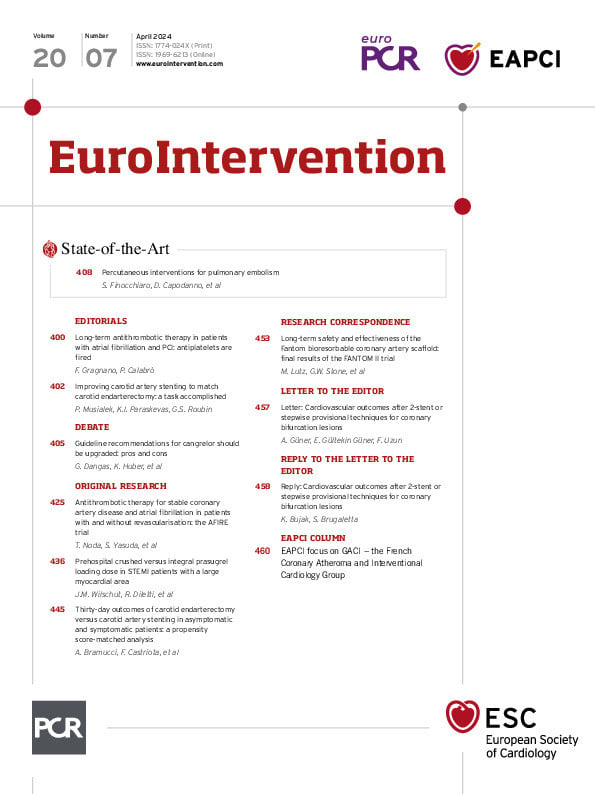We thank Güner et al1 for their interest in our paper2 and important comments. The authors of the letter expressed some concerns regarding the heterogeneity of patients’ bifurcation lesion complexity, interventional approaches, and background medical treatment in the trials included in our meta-analysis, and we thank them for the opportunity to clarify our analysis.
We strongly agree that proximal optimisation technique (POT) is an essential step in coronary bifurcation lesion treatment, recommended by the European Bifurcation Club (EBC) in case of either a provisional stenting strategy or an upfront 2-stent technique34. Although POT was introduced in the late 2000s5 and has since become a gold standard of bifurcation lesion treatment, it was not obligatory according to the protocols of the majority of randomised controlled trials (RCTs) included in our meta-analysis2. Therefore, we performed a sensitivity analysis including only those trials requiring POT. The results of this sensitivity analysis, presented in the supplementary materials of our paper, were completely consistent with the primary analysis.
The antiplatelet treatment regimen may indeed affect the outcomes of patients undergoing percutaneous coronary intervention (PCI)6. In recent years, remarkable improvements in antiplatelet therapy have been made by implementing potent P2Y12 inhibitors and more personalised treatment strategies that consider both the ischaemic and bleeding risks of individuals6. Since patients included in our meta-analysis were enrolled between 2001 and 2019, antiplatelet therapies differed substantially between the studies2. Of note, we performed a meta-regression that showed no modifying effect of the trial’s publication year on the primary outcome of major adverse cardiovascular events (MACE) following the given bifurcation stenting strategy2. This reassures us that, although background medical therapy and other aspects of interventional treatment mentioned by the authors of the letter (including devices and bifurcation stenting techniques) have evolved over the years, the main findings of our meta-analysis remain consistent. Nevertheless, owing to the varying frequencies of patients presenting with acute coronary syndrome across the studies (from 0% to over 80%) and infrequent reporting of the details of antithrombotic strategies, we were not able to perform any specific analyses focused on the effect of background antiplatelet therapy on the potential advantages of any given bifurcation stenting strategy.
Drs Güner et al1 pointed out between-study heterogeneity of bifurcation lesion features as another limitation of our meta-analysis. Indeed, the complexity of bifurcation lesions varied substantially between the included RCTs. We believe that we partially addressed this issue by performing a sensitivity analysis, which included only trials with true bifurcation lesions; it specifically showed a lower risk of MACE in patients treated with upfront 2-stent techniques. Moreover, according to the DEFINITION criteria7, the presence of a side branch lesion with a length of at least 10 mm is an obligatory criterion for classifying complex bifurcations. Accordingly, we performed a meta-regression, which showed that the longer the side branch lesion length, the greater the benefit from the 2-stent approach regarding MACE. Considering the varying definitions of complex bifurcation lesions used in the trials and the inconsistent reporting of anatomical and procedural data, analyses of other bifurcation lesion features were not feasible. However, our findings support the EBC’s recommendations, which indicate that bifurcation complexity is a vital aspect that should be considered when selecting between provisional stenting and the upfront 2-stent strategy4.
Another remark of the authors was regarding the inclusion in the network meta-analysis of 6 trials allowing different bifurcation techniques in the 2-stent arm. For this situation, we attributed events to the most often performed technique in the arm, in line with the approach used previously by other authors8. We recognise that, despite increasing the sample size, this approach may have led to less precise estimates for any given bifurcation stenting technique. For that reason, we verified our results by performing a sensitivity analysis that excluded the RCTs mentioned above, which demonstrated mostly consistent findings2.
Finally, Güner et al implied the arterial access route to be a potential confounding variable. Radial access has been shown in multiple trials to be superior to femoral access in terms of lower bleeding risk. A recent meta-analysis also showed a reduced all-cause mortality rate with that approach9. However, in some specific scenarios, a radial approach may not be optimal or feasible, especially when additional support and a large guiding catheter are needed. In this context, one may consider it possible that the operators would have been more likely to choose the femoral approach in the case of complex, 2-stent techniques for bifurcation lesion treatment. However, there was no sign of any imbalance between the arms of the 9 RCTs included in our systematic review that reported the vascular access site2. It is, therefore, unlikely that the results of our meta-analysis are biased by this factor.
Conflict of interest statement
The authors have no conflicts of interest to declare.

